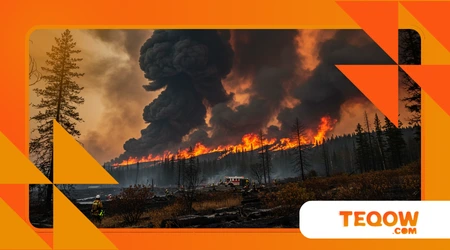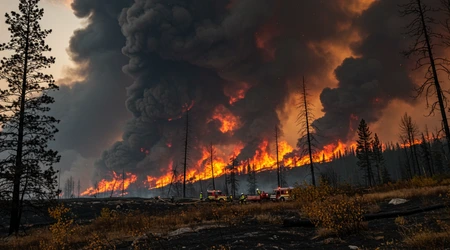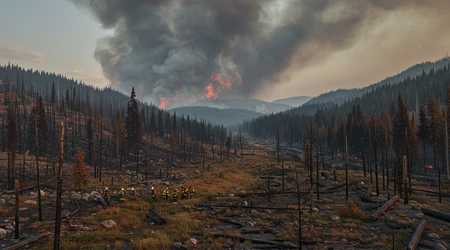Canada’s 2025 Wildfire Season Becomes Second Worst on Record

The wildfire season in Canada has etched 2025 into the annals of history as the second-worst on record, a stark reminder of nature’s unrelenting power.
Smoke blankets communities, skies turn apocalyptic, and forests vanish in flames. This year’s inferno, surpassing 6.3 million hectares burned, demands we confront the escalating reality of climate-driven disasters.
What does this mean for Canada’s future? This article dives deep into the causes, impacts, and responses to this devastating wildfire season, weaving together hard data, human stories, and a call to rethink our relationship with the environment.
From the smoldering forests of Saskatchewan to the charred landscapes of Manitoba, the 2025 wildfire season has reshaped lives and sparked urgent debates.
Over 6.3 million hectares have burned, with satellites capturing smoke plumes stretching across continents. The crisis isn’t just ecological it’s economic, social, and deeply personal.
Families have fled homes, businesses have shuttered, and air quality has plummeted to hazardous levels. As Canada battles these blazes, questions arise about preparedness, climate policy, and the path forward in an era of intensifying fires.
The Scale of the 2025 Wildfire Crisis
Canada’s wildfire season has unleashed unprecedented destruction, with 6.3 million hectares burned by early August, per the Canadian Space Agency.
Saskatchewan alone accounts for 2.3 million hectares, while Manitoba follows with 1.5 million. These numbers dwarf the annual average of 2.1 million hectares, a threshold crossed by June.
The 2023 season, the worst on record, burned 15 million hectares, but 2025’s toll is closing in fast.
Fires have raged with ferocity, fueled by prolonged heatwaves and bone-dry conditions. In Jasper, a beloved national park, flames devoured iconic landscapes, displacing thousands.
The town’s residents, like Sarah Thompson, a local café owner, watched helplessly as their livelihoods turned to ash. “It’s like losing a piece of your soul,” she said. The economic ripple effect is staggering tourism, a $100 billion industry, faces steep losses.
++ Bank of Canada Maintains Rate at 2.75%; Additional Cuts Expected in 2025
Satellites reveal smoke spreading as far as Europe, a haunting visual of the crisis’s global reach. Air quality indices in cities like Edmonton hit 175, signaling health risks.
The elderly and children suffer most, with hospitals reporting a 20% spike in respiratory cases. This isn’t just a fire it’s a public health emergency unfolding in real time.
The human toll deepens with each evacuation. In northern Ontario, entire Indigenous communities were airlifted to safety, their traditional lands scorched.
Elders like Mary Keewatin lament the loss of sacred sites. “These lands hold our stories,” she said. The fires don’t just burn trees; they erase cultural heritage, leaving scars that may never heal.

Climate Change: The Unseen Arsonist
The wildfire season isn’t an isolated event it’s a symptom of a warming planet. Environment Canada reports a 1.8°C temperature rise since 1948, amplifying fire risks.
Drier forests, longer summers, and erratic weather patterns create a perfect storm. Lightning strikes, up 15% this year, ignite tinderbox conditions, while human activity sparks 40% of blazes.
Picture a campfire left unattended, its embers catching a dry leaf now scale that to a forest baked by record heat. That’s 2025’s reality.
Climate models predict a 50% increase in fire-prone days by 2050. Yet, Canada’s carbon emissions remain stubbornly high, with oil and gas sectors contributing 30% of the total. Are we stoking the flames we’re trying to extinguish?
Also read: Canada Halts Hotel Housing for Asylum Seekers After Spending $1.1B Since 2020
Policy lags behind science. While Canada invests $800 million annually in firefighting, critics argue it’s a Band-Aid on a gaping wound.
Reforestation and prescribed burns could reduce risks, but funding is thin. Provinces like British Columbia push for greener policies, yet face resistance from industries tethered to fossil fuels. The disconnect is glaring.
Communities bear the brunt of this inaction. In Fort McMurray, residents still haunted by the 2016 fires now face new threats.
“We rebuilt, but for what?” asks local firefighter Dan Carter. The cycle of destruction feels relentless, with climate change as the unseen arsonist fanning the flames.
Economic and Social Fallout
The wildfire season has crippled local economies, particularly in rural areas. Forestry, a $25 billion industry, faces disruptions as timber supplies dwindle.
Small businesses, like those in Jasper, report 60% revenue drops. “Tourists aren’t coming,” said one hotel owner. The ripple effect hits supply chains, inflating costs nationwide.
Indigenous communities face unique challenges. Many rely on land-based economie hunting, fishing, trapping that fires have decimated.
In Manitoba, the Red Sucker Lake First Nation lost critical hunting grounds. Chief Samuel Knott described the despair: “Our way of life is burning.” Government aid, often slow, fails to address cultural losses.
Mental health is another casualty. Psychologists report rising anxiety among evacuees, with children showing signs of trauma.
Read more: Canadian Businesses Less Worried About Worst-Case Tariff Scenarios
“Kids draw pictures of burning trees,” said Dr. Lisa Nguyen, a counselor in Alberta. Community resilience is tested as people grapple with uncertainty. Support programs exist, but access is uneven, especially in remote areas.
Urban centers aren’t spared. Calgary’s air quality plummeted, forcing schools to cancel outdoor activities. Businesses sent workers home, slashing productivity.
The economic toll could reach $10 billion, per early estimates. Meanwhile, social cohesion frays as debates over climate responsibility intensify, pitting communities against policymakers.
Fighting the Flames: Strategies and Shortfalls
Canada’s firefighting efforts are Herculean but stretched thin. Over 7,000 firefighters, including international crews, battle blazes daily.
Aerial tankers drop 10 million liters of water weekly, yet fires outpace resources. “It’s like fighting a dragon with a garden hose,” said one veteran firefighter.
Technology offers hope. Satellites track fire spread, guiding evacuations. Drones deliver real-time data, pinpointing hot spots. Yet, funding for advanced tools lags.
The federal government allocated $1.2 billion for 2025, but provinces say it’s not enough. Training programs for volunteer firefighters are also underfunded, limiting local response capacity.
Community-led solutions shine through. In British Columbia, Indigenous firekeepers use traditional burning to reduce fuel loads.
“We’ve managed forests for centuries,” said Chief Clara Morin. Scaling these practices could prevent future disasters, but bureaucratic hurdles slow progress. Innovation exists, but implementation falters.
Prevention remains the weakest link. Building codes in fire-prone areas lack rigor, and urban sprawl encroaches on wildlands.
Public education campaigns, while growing, fail to reach all. Many Canadians still underestimate the wildfire season’s threat, leaving homes and lives vulnerable.
A Path Forward: Resilience and Adaptation
Rebuilding after the 2025 wildfire season demands bold action. Reforestation must prioritize fire-resistant species, like lodgepole pine, which recover faster.
Investing $2 billion in ecosystem restoration could cut future risks by 30%, per Natural Resources Canada. But will governments act decisively?
Communities are adapting. In Kelowna, residents formed fire-watch groups, using apps to share alerts. Schools now teach fire safety, embedding resilience early.
These grassroots efforts show promise, but they need national support. Federal-provincial coordination must improve to streamline aid and resources.
Policy reform is critical. Carbon pricing, while controversial, could fund mitigation. Tax breaks for green infrastructure think solar-powered fire stations might spur innovation.
Public-private partnerships could accelerate reforestation and tech development. The question isn’t whether we can act, but whether we will.
Hope lies in collective action. Volunteers in Alberta plant trees weekly, while youth groups advocate for climate policies.
“This is our fight,” said 19-year-old activist Maya Chen. The 2025 fires are a wake-up call Canada must unite to protect its land and people.
The Global Context: Canada’s Fires in Perspective

Canada’s crisis mirrors global trends. Australia’s 2020 fires burned 24 million hectares, while California’s 2024 season scorched 1.5 million.
Climate change links these disasters, with rising temperatures amplifying fire risks worldwide. Canada’s 2025 wildfire season is a chapter in a larger story.
International cooperation is vital. Canada shares firefighting resources with the U.S. and Australia, but global strategies lag.
The UN’s climate fund, at $100 billion annually, falls short of the $300 billion needed for adaptation. Wealthy nations, including Canada, must step up.
Lessons from abroad can guide Canada. Sweden’s 2018 fires prompted stricter land-use policies, reducing risks.
Canada could adopt similar measures, like zoning laws to limit development in fire-prone areas. Global knowledge-sharing is key to resilience.
The fires also highlight inequity. Developing nations face similar risks with fewer resources.
Canada’s expertise in satellite monitoring could aid countries like Indonesia, where fires rage unchecked. Solidarity in crisis can redefine global climate action.
Data Snapshot: 2025 Wildfire Season by the Numbers
| Region | Hectares Burned | Evacuations | Economic Loss (Estimated) |
|---|---|---|---|
| Saskatchewan | 2.3 million | 15,000 | $2.5 billion |
| Manitoba | 1.5 million | 10,000 | $1.8 billion |
| British Columbia | 1.2 million | 8,000 | $3.0 billion |
| Ontario | 0.8 million | 5,000 | $1.2 billion |
Source: Canadian Space Agency, August 2025
Conclusion: A Call to Action
The 2025 wildfire season has seared Canada’s landscape and psyche, a grim milestone as the second-worst on record.
It’s more than a statistic it’s a clarion call. From Jasper’s ashes to Manitoba’s scorched fields, the fires expose our vulnerabilities and demand action.
Climate change fuels these blazes, but human ingenuity can douse them. Will we rise to the challenge or let the flames define our future?
Communities show resilience, from Indigenous firekeepers to youth activists. Yet, systemic change bolder policies, smarter investments, global cooperation is non-negotiable.
Canada’s forests, economy, and people deserve a future where fires don’t dictate fate. Let’s act now, before the next wildfire season writes an even grimmer chapter.
Frequently Asked Questions
How does the 2025 wildfire season compare to past years?
The 2025 season, with 6.3 million hectares burned, is the second-worst since 1983, behind 2023’s 15 million hectares. It surpassed the 2.1 million hectare average by June.
What can individuals do to help during the wildfire season?
Clear vegetation around homes, like Jane in Kelowna who trimmed her yard, reducing fire risk. Support local relief funds, as seen in Alberta’s community drives.
